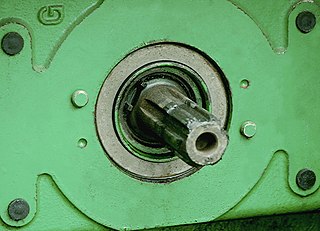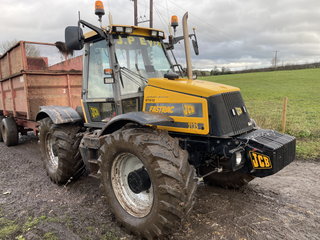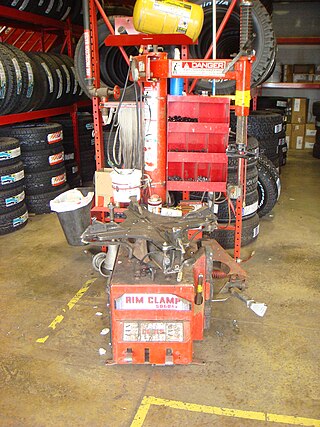
A radio-controlled model is a model that is steerable with the use of radio control (RC). All types of model vehicles have had RC systems installed in them, including ground vehicles, boats, planes, helicopters and even submarines and scale railway locomotives.

A tractor is an engineering vehicle specifically designed to deliver a high tractive effort at slow speeds, for the purposes of hauling a trailer or machinery such as that used in agriculture, mining or construction. Most commonly, the term is used to describe a farm vehicle that provides the power and traction to mechanize agricultural tasks, especially tillage, and now many more. Agricultural implements may be towed behind or mounted on the tractor, and the tractor may also provide a source of power if the implement is mechanised.

A power take-off or power takeoff (PTO) is one of several methods for taking power from a power source, such as a running engine, and transmitting it to an application such as an attached implement or separate machine.

A continuously variable transmission (CVT) is an automated transmission that can change through a continuous range of gear ratios. This contrasts with other transmissions that provide a limited number of gear ratios in fixed steps. The flexibility of a CVT with suitable control may allow the engine to operate at a constant angular velocity while the vehicle moves at varying speeds.

A manual transmission (MT), also known as manual gearbox, standard transmission, or stick shift, is a multi-speed motor vehicle transmission system, where gear changes require the driver to manually select the gears by operating a gear stick and clutch.

The International Harvester Company was an American manufacturer of agricultural and construction equipment, automobiles, commercial trucks, lawn and garden products, household equipment, and more. It was formed from the 1902 merger of McCormick Harvesting Machine Company and Deering Harvester Company and three smaller manufacturers: Milwaukee; Plano; and Warder, Bushnell, and Glessner. Its brands included McCormick, Deering, and later McCormick-Deering, as well as International. Along with the Farmall and Cub Cadet tractors, International was also known for the Scout and Travelall vehicle nameplates. In the 1980s all divisions were sold off except for International Trucks, which changed its parent company name to Navistar International.

Hydraulic machines use liquid fluid power to perform work. Heavy construction vehicles are a common example. In this type of machine, hydraulic fluid is pumped to various hydraulic motors and hydraulic cylinders throughout the machine and becomes pressurized according to the resistance present. The fluid is controlled directly or automatically by control valves and distributed through hoses, tubes, or pipes.
A relay valve is an air-operated valve typically used in air brake systems to remotely control the brakes at the rear of a heavy truck or semi-trailer in a tractor-trailer combination. Relay valves are necessary in heavy trucks in order to speed-up rear-brake application and release, since air takes longer to travel to the rear of the vehicle than the front of the vehicle, where the front service brakes, foot-valve, parking-control valve, and trailer-supply valve are located.

The Studebaker US6 (G630) was a series of 2+1⁄2-ton 6×6 and 5-ton 6×4 trucks manufactured by the Studebaker Corporation and REO Motor Car Company during World War II. The basic cargo version was designed to transport a 2+1⁄2-short-ton cargo load over any type of terrain in any weather. Most of these were exported to the Soviet Union under Lend-Lease by the US during World War II, since the competing GMC 6×6 CCKW design proved to be more suitable for Western Front conditions.

The Morris Commercial C8 FAT, commonly known as a (Beetle-back) Quad, is an artillery tractor used by the British and Commonwealth, during the Second World War. It was used to tow field artillery pieces, such as the 25-pounder gun-howitzer, and anti-tank guns, such as the 17-pounder.

The Mercedes-Benz Actros is a heavy-duty truck introduced by Mercedes-Benz at the 1996 Commercial Vehicle IAA in Hanover, Germany, as the replacement for the SK. It is normally used for long-distance haulage, heavy-duty distribution haulage, and construction haulage. It is powered by an inline-6 diesel engine with a turbocharger and intercooler. Daimler Trucks/Lorries launched version II of the Actros in 2002 and version III in 2007. The fourth generation of the Actros, officially named "the New Actros," launched in July 2011.

A non-synchronous transmission, also called a crash gearbox, is a form of manual transmission based on gears that do not use synchronizing mechanisms. They require the driver to manually synchronize the transmission's input speed and output speed.

In vehicle acrobatics, a wheelie, or wheelstand, is a vehicle maneuver in which the front wheel or wheels come off the ground due to sufficient torque being applied to the rear wheel or wheels, or rider motion relative to the vehicle. Wheelies are usually associated with bicycles and motorcycles, but can be done with other vehicles such as cars, especially in drag racing and tractor pulling.

The JCB Fastrac is a high-speed agricultural tractor series manufactured by JCB Landpower, part of the JCB group.

A tire changer is a machine used to help tire technicians dismount and mount tires with automobile wheels. After the wheel and tire assembly are removed from the automobile, the tire changer has all the components necessary to remove and replace the tire from the wheel. Different tire changers allow technicians to replace tires on automobiles, motorcycles and heavy-duty trucks. New tire and wheel technology has improved certain tire changers to be able to change a low profile tire or a run-flat tire.

Western Star Trucks Sales, Inc. is an American truck manufacturer headquartered in Portland, Oregon, and a subsidiary of Daimler Truck North America, which is an independent subsidiary of the multinational Daimler Truck. Western Star trucks are commonly sold at Freightliner dealerships.

A terminal tractor, known in the United States as a shag truck, shunt truck, spotter truck, spotting tractor, yard truck, yard shifter, yard dog, yard goat, yard horse, yard mule, yard jockey, yard spotter, hostler, or mule, is a kind of semi-tractor intended to move semi-trailers within a cargo yard, warehouse facility, or intermodal facility, much like a switcher locomotive is used to position railcars. In the United Kingdom they are known as terminal lorries or terminal trucks.
The Farmall 04 series tractors are a family of row-crop tractors with four-cylinder engines, continuing the tradition of four-cylinder engines in Farmall and parent company International Harvester for general-purpose and row-crop tractors. In the early 1960s demand for more power led to the 06 series with six-cylinder engines. Four-cylinder engines were reserved for tractors equivalent to the Farmall H and smaller.

The Farmall 06 series tractors are a family of row-crop tractors with six-cylinder engines, providing greater horsepower than the parallel product line of four-cylinder Farmall 04 series tractors. Until the late 1950s, Farmall and parent company International Harvester tractors used four-cylinder engines for general-purpose and row-crop tractors. Demands for higher performance and greater horsepower led to broader use of six-cylinder engines, with the bulk of International's production moving to the larger engines. The Farmall 806 and 706 were introduced in 1963, with production running to 1967. The Farmall 1206 was introduced in 1965 as the most powerful tractor of its time, using a turbocharged diesel engine. Production of the 1206 also ran until 1967. The 06 series sold well and was regarded as extremely successful.

The Farmall eight-cylinder tractor line or Farmall 08 series was briefly produced near the end of the Farmall product run, in response to pressure to increase horsepower and to match competing brands.

















